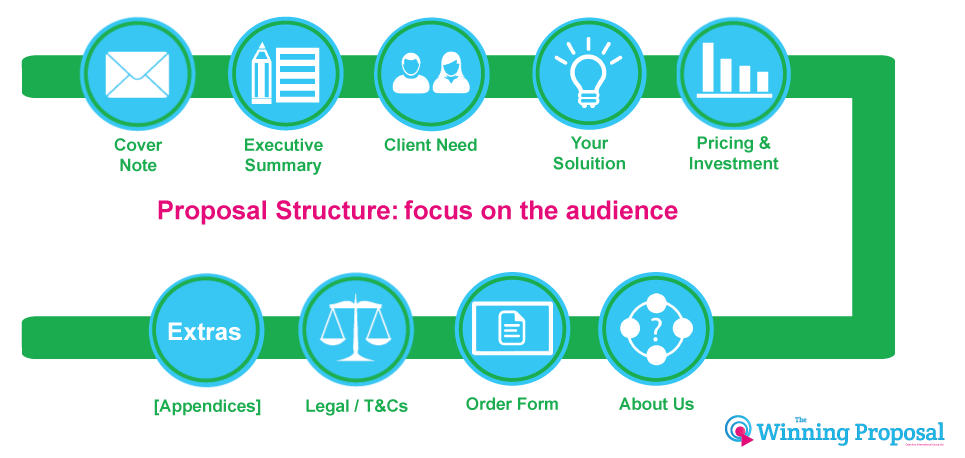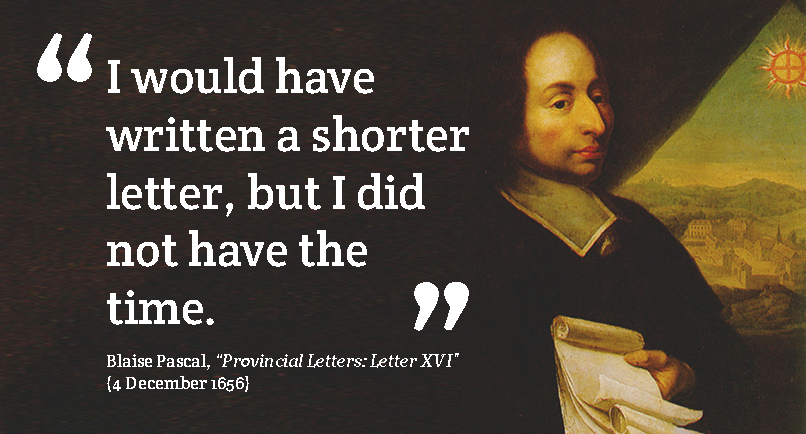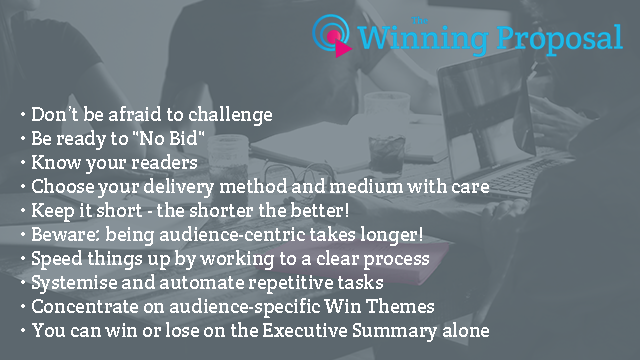Where are you on the Proposal Spectrum?
There are many kinds of sales proposal. Some are nice and short where – essentially – all you are doing is confirming in writing what is already known by your prospect following your meetings and phone discussions. Equipped with your short, written proposal your prospect has something that they can show to their boss or to Procurement, should they need to.
At the other end of the spectrum is the big, fat, extremely detailed tender that you are required to submit in the most competitive environments, usually where you are pitching a high-value, bespoke solution. These are the proposals that people often hate putting together.
You can be at either end of the spectrum, or anywhere in between; but to create the winning sales proposal you need to be aware of tried-and-tested guidance that works for every sort of proposal.
The only real difference between proposal types is the amount of time you spend in the application of the guidance, the formality of your approach and the number of people from your end that need to be involved.
Don’t be afraid to Challenge
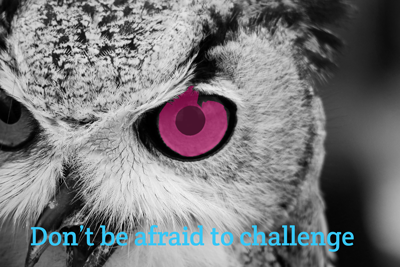 You really want this deal, right! So, when your prospect asks you for your proposal you’ve just been given the strongest possible buying signal. At this point it’s tempting to go into the CRM system, increase the likelihood of the deal dropping, move the opportunity to a more advanced sales stage and then get into Word and start typing. You might even start thinking about how you could spend the commission.
You really want this deal, right! So, when your prospect asks you for your proposal you’ve just been given the strongest possible buying signal. At this point it’s tempting to go into the CRM system, increase the likelihood of the deal dropping, move the opportunity to a more advanced sales stage and then get into Word and start typing. You might even start thinking about how you could spend the commission.
As a child, my teachers would often ask someone who had been naughty in the classroom “why did you do it?” The response was invariably “I don’t know” or “because Peter [the real culprit] told me to do it”.
Just because someone is asking you for a proposal means nothing. Absolutely nothing.
Before you invest any time in developing a proposal be sure ask a few basic questions of your prospect. Your questions can be challenging, but that doesn’t mean that they should be asked in a challenging fashion. They shouldn’t. Good, probing questions can include:
- “When do you want the proposal by?”
- “Who is going to read it?”
- “What is the process at your end?”
- “When are you making the purchasing decision and how will it be communicated?”
- “Who is involved and what are their roles?”
Do you even need to write a Proposal Document?
There’s a very simple rule of thumb with proposals:
The shorter the proposal, the more likely you are to win the business,
This rule of thumb doesn’t mean that you should just knock out a couple of paragraphs and wait for the order! But if you have sold well up to the point that you submit your proposal then your proposal should be the icing on the cake. (But do note the caveat here: “if you have sold well”).
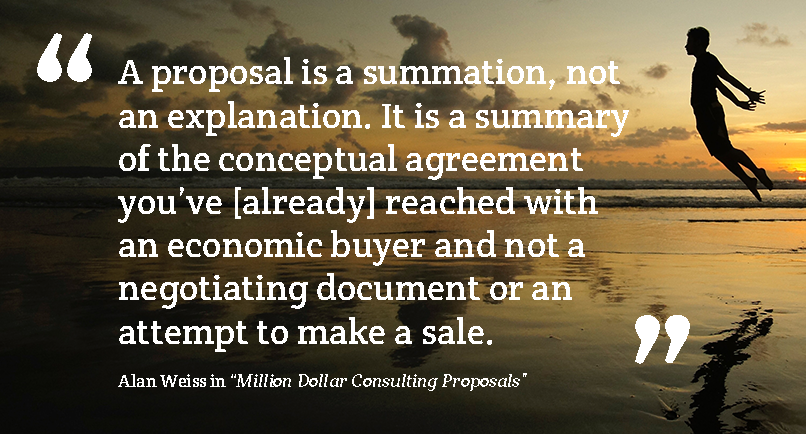 Where you are asked for a proposal when you have only done a little selling – or none – you should be very careful: you are probably just making up the numbers and your work will receive little or no attention. Your time will, unfortunately, be squandered.
Where you are asked for a proposal when you have only done a little selling – or none – you should be very careful: you are probably just making up the numbers and your work will receive little or no attention. Your time will, unfortunately, be squandered.
However, when you have sold well and proactively, your proposal should simply confirm what has been discussed. And because you already know what is really important to your prospect you can keep it short – very short! – and focus only on those areas that you know are relevant.
This doesn’t apply in “cold” bid situations where you are replying to a formal RFP (Request for Proposal) where we have to “play the game” and provide all the prescribed information, which might mean that your submission has to run to several hundreds of pages. In these cases, unless we have an existing relationship with the prospect, we are indeed obliged to attempt to “sell” through the proposal.
So, when asked to deliver your proposal ask “what are you going to do with it?”. If the prospect can’t or won’t answer this pretty easy question you might be selling to the wrong person in the organisation. Or perhaps it’s just too soon in the sales cycle to merit your investing time in a proposal. Step back or even walk away.
Conversely, if you obtain clear and honest assurances that your proposal is “just to confirm our conversations and agreement to date” then you know you can keep it very short. A verbal assurance from your side may even be sufficient and you can avoid the written proposal obligation entirely. (Yes!)
Key learning? Don’t fall into the trap of assuming that your proposal will do the selling. It’s down to you to do the selling – the proposal is the icing on the cake at the end of the sales cycle.
What are they Going to Do with it?
You are being asked to invest your time in a proposal development process. It’s only fair, isn’t it, that you should ask for something in return? The proposal might take you 30 minutes to develop, it might take you 30 days or more, so how is your commitment being met by the prospect and their buying team?
A clear understanding of what will happen once your proposal has been received will give you great confidence that you really are part of a genuine buying process. Without those assurances, you are likely to be wasting your time.
Who is Going to Read it?
 It’s so very tempting to create something that you know will resonate with the person (or people) that you have been dealing with to date. But if the proposal is to be used correctly (and shared inside the prospect’s organisation) then this is likely to mean that your document will fall into the hands of people you don’t know so well, or at all.
It’s so very tempting to create something that you know will resonate with the person (or people) that you have been dealing with to date. But if the proposal is to be used correctly (and shared inside the prospect’s organisation) then this is likely to mean that your document will fall into the hands of people you don’t know so well, or at all.
What is their involvement in the process? What is their degree of influence on the purchasing decision? What are they like? What is their expertise and areas of interest? Individual readers – your decision influencers! – may have very different areas of interest. To win their support, therefore, the proposal must be crafted to meet all individual needs and interests, which means asking the right questions up front to identify these. The answers gleaned provide the roadmap for proposal development.
Choose your Delivery Method and Medium carefully
How are you going to get your proposal to your prospect? Hand delivery is always the best since this provides the “personal touch” that so often makes a big difference in sales.
However, this is not always possible or economically viable. In some cases (RFP situations especially) physical contact with your prospect may be prohibited and you risk elimination from the process.
Many proposals are still developed in Microsoft Word, but for a very short proposal a simple email (without an attachment) may be just perfect. Do you need to provide any more than an email to be successful with this “proposal”?
The world is increasingly visual – buyers like powerful pictures and revealing diagrams – so something like Adobe InDesign CC will add visual panache to the completed proposal when it is appropriate to go down the more formal proposal route. And Word can really be made to sing and dance if you have internal resources to support you. But purely gratuitous graphics do annoy and therefore should be avoided.
Whether you are providing a short proposal by email or something much longer, following a clear and sensible structure for your document will help compel your reading / buying audience that your solution best meets their needs.
Let’s be clear though – the proposal structure can – and should – be flexed so that you are only delivering to your prospect what is required to win their business. For very short proposal documents each section might just be a couple of sentences or a paragraph or two. The guidance below assumes that a longer, higher value proposal is required to win the business.
Structure
- Cover letter / accompanying email – no more than a page (of the most succinct wording possible) to provide your contact details (to facilitate progression to the next stage), point to your “Win Themes” and confirm your enthusiasm and readiness to participate in the buying stages following proposal submission.
- Executive Summary – The most important element of your proposal (ideally just one page, certainly no more than two). Clearly state your agreed Win Themes using simple, audience-centric language. Show your solution in the form of a simplified diagram. For those prepared to tackle your proposal in full a strong Executive Summary sets the scene beautifully. For those who won’t / don’t read beyond Executive Summaries you have delivered the essence of your proposal very succinctly – and this will be much-appreciated!
- Understanding of Client Need – prove that you fully grasp the needs, problems and challenges faced by you prospect. Do not talk about your solution here – that’s next.
- Solution – In the context of stated client need (earlier) summarise your proposed solution, making sure you clearly tie back the features and benefits of your solution to stated needs. Pepper your solution section with case studies from organisations with similar attributes to your prospect and sprinkle it with positive client testimonials. Ensure these stand out from the body of the text using visual highlighting techniques (bolding, colour, use of sidebars etc.). Restrict your proposal only to the known, stated requirements. Including information not directly relevant to client need isn’t “value add”, it’s irrelevant drivel that alienates buyers.
- Pricing and Investment – organisations can’t buy from you if they don’t know the price. Many readers will often skip straight to this section. If you are lucky they will have read the Executive Summary first so will have an appreciation of the wider context. For many proposal authors it’s really hard to know how to optimally communicate costings information – pricing can make everyone somewhat uncomfortable. Seeing prices in black and white is off-putting, so present your costings in the light of a Return on Investment (RoI) case so that the lingering memory isn’t one of having to part with a lot of money, it’s one of quantified savings and other (less measurable) benefits which might include reputation gains, improved job satisfaction for solution users etc.)
- About Us – how credible are you are a potential supplier? If you have got as far as being asked to present a proposal (and you are proposing at the appropriate time in the sales cycle), some or all of your audience will know something about you. Avoid “War and Peace”. Try to restrict yourself here to just a couple of pages on what makes you credible from the audience perspective. This is likely to include details of existing clients (only those in the same / similar sector), case studies and quotes. Repeating (the very best of) case studies and testimonials referenced earlier (in the solution section) will reinforce their power. Some repetition is not only acceptable – it is vital.
- Order Form – a short, one page order form facilitates progression to the next step; it acts as a clear call to action, reminding your reader that your carefully crafted proposal merits a commercial response.
- Legal / T&Cs (option) – in the interests of brevity you may wish to provide a hyperlink (e.g. on the order form to standard T&Cs).
- Appendices – many organisations use multiple appendices as “buckets” to hold additional information that might be relevant. This tends to mean, in practice, that the appendices hold a lot of information that isn’t relevant and serves to put off readers by making the proposal thick, unwieldly and less relevant than it should be. At best appendices dilute the main thrust of the proposal. If you have truly understood and addressed explicit client need in your earlier sections, there may be no need for an appendix of any sort. If the prospect needs additional information (beyond what was initially asked for prior to document submission) they will come back to you at a later time and ask for it (a real buying signal that should trigger excitement!).
Optimal Proposal Length?
The shorter the better! The more you know about your prospect, the more you will be able to narrow and sharpen your arguments.
There is a direct association between long, bloated proposals and loss rates.
Ask yourself this: how many of your proposals start their life as a “Save As” from an earlier proposal; and do you then start pasting in additional bits from elsewhere that you believe are relevant?
This is completely normal and standard practice, but also wrong. Very wrong. This approach is symptomatic of the proposal writer who is seeing things largely from their own perspective and who is trying to make the job of developing the proposal as fast and as convenient as possible for themselves.
Start not with yourself but with the audience. Attempt to step into the shoes of your readers and buyers and see the world as they see it. When you switch the perspective by 180 degrees it is far easier to work out what your key win themes need to be – the things that your audience want to read about, want to buy. Only then do your text, diagrams, graphics, case studies, testimonials and content in general combine to genuinely support what is vitally important, and so “avoid the bloat”.
There is a major problem though:
That problem is time. It takes longer to write a shorter, more relevant, more compelling proposal than a longer, flabby one.
Since your proposal development resources are limited it therefore makes sense to restrict yourself to developing shorter proposals, since these are the ones you should be winning, even if – paradoxically – they may take longer to develop.
Developmental Process
Time and resources are precious. A defined and optimised process makes things as slick and as fast as possible, with everyone knowing their responsibilities in the proposal development cycle.
Cornerstones of your development process should include:
- Bid vs No Bid review (work out whether you are prepared to expend resources or not)
- Win Theme definition and wordsmithing
- Scheduled review sessions (nominated sections and the proposal in full)
- Senior level sign-off
Ironically, the closer you are to your prospect and a detailed understanding of their requirements (in other words, the more selling you have done prior to proposal submission) the less rigorous the process needs to be for a successful win outcome. But even then, ask a colleague to look at your proposal before submission; ideally someone who has not been involved in the sale. Their objectivity might highlight something you may have missed (or something that you don’t need to include at all).
Proposal Systems – Stop doing the Boring, Repetitive Stuff
With a strong process in place you will more clearly perceive that you do some things over and over again, so the challenge down the line is to avoid a “mechanical approach” that numbs the mind when it needs to be at its razor sharpest.
Developing proposals “by numbers” will take you away from your audience. But there is hope … investing in systems / systemisation can bring great rewards.
By simplifying – and even totally automating – certain aspects of the development cycle you are able to free up time for those tasks that really are critical, namely those elements of your bid that must speak clearly and directly to your selected audience. How? Consider, for instance, doing this
- Create and maintain a library of telling diagrams (diagrams are more interesting to the reader and save you generating unnecessary text)
- Build an image library of impactful photos, images and other eye-grabbing graphics
- Create a repository of case studies and supporting client testimonials to bolster the credibility of your offer and your organisation
- Create high class “text snippets” (paragraphs of approved, set text written to a very high standard) that you can legitimately re-use across many of your proposals
- Implement a Document Management System (DMS, which will also assist eradicate any version control issues)
- Check out one of the new generation of high-tech proposal systems that are currently emerging such as Octiv
Summary
- Don’t be afraid to challenge
- Be ready to “No Bid”
- Know your readers
- Choose your delivery method and medium with care
- Keep it short – the shorter the better!
- But being audience-centric takes longer!
- Speed things up by working to a clear process
- Systemise and automate repetitive tasks
- Concentrate on audience-specific Win Themes
- You can win or lose on the Executive Summary alone
Can we Help You?
The Winning Proposal works with sales organisations to develop more impactful and successful winning sales proposals.
If you would like to explore any of the ideas raising in this article we’d love to hear from you!

